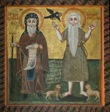Icon with St.
Barbara
Inv. No. 3451, Painted wood
Western style / Italy ?
St. Barbara Church, 15th century
St. Barbara is among the most popular Christian saints in
the East and West. She was locked in a tower by her pagan
father, the rich Dioscuros from Nikomedia (today’s Ízmit in
Turkey), who was envious of his beautiful young daughter.
While he was travelling, Barbara converted to Christianity
and eventually was beheaded by her own father.
Icon
with Sts. Sergius and Bacchus on one side and a face on
the other
Inv. No. 3360
Tempera and gilt on linen and wood
H: 42 cm, W: 28 cm
Probably from Wadi el-Natrun, Monastery of the Syrians, ca.
1300
St. Sergius (on the left) and St. Bacchus (on the right)
were two Syrian soldiers in the Roman army and suffered
martyrdom in 296. Their names are written in Greek next to
their heads. They wear Byzantine court dresses and gold
collars around their necks. In one hand they hold swords
and and in the other they carry staffs against their
shoulders. The other side of the icon depicts a face. The
hair is set with a diadem decorated with red and green
jewels.
Icon
with St. Anthony visiting St. Paul of
Thebes
Inv. No. 3418
Painted wood
H: 55 cm, W: 56 cm
Old Cairo, Monastery of Mercurius (Abu Sayfayn),
1777
St. Paul (on the right) is regarded as the first Christian
hermit; St. Anthony (on the left) is called the “Father of
the Monks”. Their names are written in Coptic next to the
halos surrounding their heads. Both saints met each other
towards the end of Paul’s life (c. 343) who was buried by
Anthony in a grave dug by lions. According to the “Life of
St. Paul” written by St. Jerome, St. Paul was barefoot and
dressed in a coarse garment made of palm leaves. St.
Anthony is depicted in the conventional vestment of a monk.
Icon
with the Flight of the Holy Family into
Egypt
Inv. No. 3350
Painted wood
H: 77 cm, W: 54,7 cm
Unknown Provenance, 18th century (?)
In the centre of the depiction is the Virgin Mary riding on
a white horse. Jesus is seated on St. Joseph’s right
shoulder. In the background, a town with white houses
refers to Egypt, the place of refuge. The sojourn of the
Holy Family into Egypt plays an important role in the
Coptic Church and is annually celebrated on the 1st of
June.
Icon
with Jesus entering Jerusalem as a
King
Inv. No. 3463
Painted wood
Akhmim style, 18th century
This icon depicts the triumphant entry of Jesus into
Jerusalem as a king. People line the path and throw their
garments in front of the donkey carrying Jesus. This event
is called “Palm Sunday”, as people welcomed Christ by
throwing palms in his way and is regarded as one of the
major feasts in the Coptic Church.
The other side of the panel shows the Crucifixion.
Icon with the
Nativity
Inv. No. 3848
Paintd wood
H: 36,3 cm, W: 29,4 cm
Greek style, 17th century
Presented by Mrs. Hykyan Pasha
In the centre of the painting, the newly born Christ is
lying on a red bed inside a cave. An ox and a donkey
approach the newly born with curiosity. In front of the
cave the reclining Virgin Mary is wrapped in a cloth. To
her left the three Magi on horseback point to the star of
Bethlehem. In the upper left corner three angels witness
the marvelous meeting below. To the left at the bottom
Joseph is shown as an old man, in front of him is the devil
in the disguise of an old man, trying to convince Joseph to
leave Mary. In the upper right corner, an angel announces
the good news to a shepherd.





